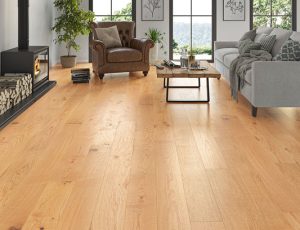Engineered hickory flooring is growing in popularity among homeowners and designers because it combines natural beauty with practical performance. Unlike traditional solid wood, engineered hickory is designed for enhanced durability and versatility, making it an ideal choice for many modern living environments. This guide breaks down its key benefits to help you decide if it’s the right fit for your space.
Stability and Performance
One of the most significant advantages of engineered hickory flooring is its dimensional stability. Thanks to its multi-layered construction, this flooring resists warping and swelling caused by humidity or temperature fluctuations.
Layered Construction
Engineered hickory is made of a real hardwood veneer on top and multiple layers of plywood or fiberboard underneath. These layers are arranged in a cross-grain pattern that minimizes movement and makes the floor more stable over time.
Moisture Resistance
Compared to solid wood, engineered hickory performs better in damp or humid areas like basements or kitchens. Its structure handles moisture better, reducing the risk of expansion, contraction, or cupping.
Design Flexibility
This flooring option doesn’t sacrifice aesthetics for performance. Engineered hickory showcases the same distinct grain patterns and natural color variation as solid hickory, offering a high-end look.
Range of Styles
Available in finishes like matte, satin, or glossy, engineered hickory suits both rustic and contemporary interiors. You can also choose from smooth, wire-brushed, or hand-scraped textures depending on your design preference.
Color Variants
Natural hickory flooring comes in a blend of light and dark tones, often within a single board. Engineered versions may also come in stained options, such as gray, espresso, or even whitewashed hues for a custom feel.
Ease of Installation
Another reason to consider engineered hickory is its simple and flexible installation methods. Whether you’re doing it yourself or hiring professionals, installation is usually faster and less complex than solid hardwood.
Floating Floor Option
Many engineered hickory planks can be installed as a floating floor, where the boards lock together without nails or glue. This method is convenient and minimizes mess during installation.
Over Radiant Heat or Concrete
Unlike traditional wood floors, engineered hickory can be safely installed over radiant heating systems or concrete subfloors. This opens up possibilities for use in basements and other tricky areas.
Low Maintenance and Longevity
Durable and easy to maintain, engineered hickory flooring requires only basic care to preserve its appearance. It offers long-term value for families and homeowners looking for a practical hardwood option.
Everyday Cleaning
Sweeping or vacuuming to remove dust and occasional damp mopping are typically enough to keep the floor clean. It’s important to avoid excessive water or harsh chemicals to protect the finish.
Wear Layer Thickness
Some engineered hickory floors feature a thick top layer that allows for one or two rounds of sanding and refinishing. This can extend the life of your floor by many years, making it a worthwhile investment.
Cost and Value
While engineered hickory is generally more affordable than solid wood, it still adds real estate value and visual appeal to a home. It strikes a good balance between quality, performance, and cost.
Price Range
Prices vary depending on the thickness of the veneer, the type of core, and the finish. You can expect to pay between $3 and $10 per square foot, making it suitable for both budget-conscious and premium renovations.
Return on Investment
Because of its durability and aesthetic value, engineered hickory can contribute to better home resale potential. It’s especially appealing to buyers looking for the charm of hardwood with fewer maintenance concerns.




